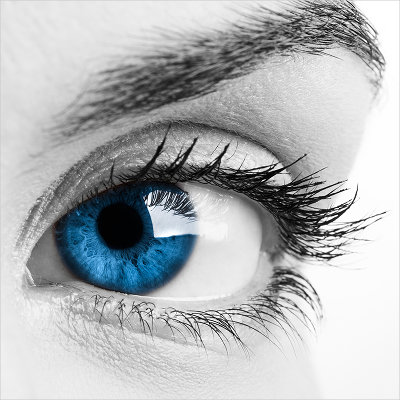
IRIS RECOGNITION
The iris is the colored circular structure at the front of the eye which controls the diameter and size of the pupil. The texture pattern of each iris is highly unique, providing more information for authentication than a single fingerprint or face.
Ziphio Coconut platform provides iris authentication for customers when available on their smartphones, alongside more widely available biometric options.
How does voice authentication work?
The iris pattern is different for both of an individual’s eyes, so capturing information from each eye together provides the best accuracy. The iris pattern is fixed before birth and remains stable throughout a person’s life.
Although iris color is not used as part of the recognition process, it is a factor: with darker iris colors, the details of the iris pattern cannot be seen using only regular visible light. By illuminating the eyes with near-infrared light, the pattern details can be captured. One or more infrared illuminators and cameras are required to produce this specialized light during capture for iris recognition. Since humans are unable to see infrared light, the capture appears no different than a regular face capture and uses similar hardware to some 3D face solutions.
Iris recognition algorithms work by locating and extracting the iris circular area from the photo of the full eye region, followed by comparing iris areas, from two different captures, using mathematical pattern recognition techniques. Since the iris can vary in size, as the pupil dilates or shrinks, adjustments are made to allow for these changes.
Applications of iris authentication
Specialized iris capture cameras have been in use in government and enterprise applications for many years. For example, some national identity projects use iris to help ensure that each citizen can only obtain a single identity number. In some airports, iris is used both to authenticate travellers and to search against a ‘watch list’ of known suspects. Iris capture devices used have many different form factors ranging from handheld binocular devices, to cameras mounted on walls and within kiosks, to devices that capture iris images at a distance of several meters away while a user is approaching..
Iris has not yet been widely deployed on smartphones, partly due to needing an additional embedded infrared illuminator and a camera sensor that can be used for both infrared iris capture and visible light photos. Sunlight also contains significant amounts of near-infrared light and this can interfere with the iris capture in some outdoor settings, unlike fingerprint or voice. The number of smartphones providing iris recognition is expected to increase in the coming years.
ADVANTAGES OF IRIS RECOGNITION AND A BIOMETRIC AUTHENTICATION SYSTEM – IDENTITYX
Some of the most critical advantages of an iris recognition biometric authentication system are:
-
-
-
- Accuracy: The iris authentication matches the complex mathematical patterns of the irises. Biometric authentication found that the false rejection rate of iris recognition is <2%
-
-
-
- Hygiene: An Iris can be scanned from a distance which helps ensure excellent hygiene. It is the same as taking a picture and doesn’t require any physical contact.
-
-
-
- Easy to use: The person needs to stand still in front of the camera for Iris recognition to take place. It is an easy to use process for everyone.
-
-
-
- Scalability: Iris biometric authentication is highly scalable. The technology has been deployed in many government and private projects.
-
-